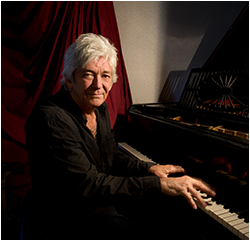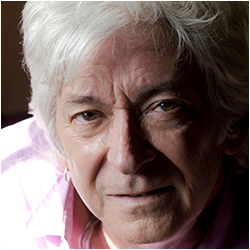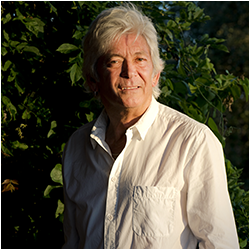 |
 |
 HTN Web Feature HTN Web Feature 
|
|
|
A Rock ’n’ Roll Legend With the Greatest of Smiles by Brian Robbins  For many, their mental image of Ian “Mac” McLagan is the impish rogue behind the keyboards for the Faces, cigarette dangling from his lips and a glass of spirits always within reach. But Ian McLagan has made some amazing contributions to the soundtrack of our world since the Faces’ breakup in 1975. He’s toured with the Rolling Stones and sat in with the Black Crowes; his session work is multi-generational, working with artists as varied as Bob Dylan, Joe Cocker, Chuck Berry, Bruce Springsteen, Taj Mahal, Izzy Stradlin, Melissa Etheridge, John Meyer, Warren Haynes, Frank Black, Bonnie Raitt...the list goes on and on. And in amongst it all McLagan has recorded a string of solo albums that showcase his talents as frontman and vocalist, along with a keyboard style that is as at home with a reggae groove as it is with a barroom romp. For many, their mental image of Ian “Mac” McLagan is the impish rogue behind the keyboards for the Faces, cigarette dangling from his lips and a glass of spirits always within reach. But Ian McLagan has made some amazing contributions to the soundtrack of our world since the Faces’ breakup in 1975. He’s toured with the Rolling Stones and sat in with the Black Crowes; his session work is multi-generational, working with artists as varied as Bob Dylan, Joe Cocker, Chuck Berry, Bruce Springsteen, Taj Mahal, Izzy Stradlin, Melissa Etheridge, John Meyer, Warren Haynes, Frank Black, Bonnie Raitt...the list goes on and on. And in amongst it all McLagan has recorded a string of solo albums that showcase his talents as frontman and vocalist, along with a keyboard style that is as at home with a reggae groove as it is with a barroom romp.Though Mac’s smile is almost as well-known as his music, his story has a tragic side. In 2006, he lost his wife of twenty-eight years, Kim, to a car accident close to their home in Austin, TX. Shaken by the loss of the love of his life, McLagan chose to wrap himself up in music, both collaborating with others (his piano on “Save Me,” the final track on Warren Haynes’ 2011 Man In Motion album, is particularly soul-wrenching) and leading his Austin-based Bump Band, which includes guitarist “Scrappy” Jud Newcomb, bassist Jin Notarthomas and drummer Conrad Choucroun. 2014 saw the release of United States, a ten-track studio album that captures McLagan and the Bump Band at their best, brilliantly formation-flying while keeping it loose as a goose. We had a chance to talk with Mac about the making of United States – covering everything from piano vs. guitar as a writing tool to what Rembrandt was missing all along. And when you talk with Ian McLagan, you laugh. A lot. Because he laughs. A lot. And it doesn’t matter that Mac’s a rock ’n’ roll legend: he still calls it a “pianna.” Hittin’ the Note: Mac, congratulations on the new album. You’ve got to be so tickled with this – it's a great piece of work. Ian McLagan: Oh, thank you. I am thrilled, but it’s one of those things: “Oh, it’s released finally” ? and then you realize hardly anyone’s going to listen to it, as there’s too much music out there! (laughs) Yeah, there’s a lot out there, but there’s only so much worth listening to! Well, that’s the truth. If you like mine, then I like you liking it! That makes me very happy. But, yeah ? I’m very proud of it. It’s my baby. Did you write these ten tunes specifically for the album or had you road tested them first? We played most of them live first. “Love Letter” we didn’t – we played that for the first time in the studio. I’ve had “Pure Gold” as a song for over twenty years, you know; I’ve recorded it a couple times with different versions of the Bump Band and it didn’t work. But this time we had the right drummer; the right guitarist; the right bass player...the right singer! (laughs) And it came together. I never give up on a song, so if it ain’t happening this time, maybe it will later on; maybe another day; maybe later in the day; maybe twenty years on, you know? This was its time, for sure. Had you worked with engineer Darwin Smith before? No – in fact, we're making plans to start the next album and he’ll be engineering that unless something changes. Darwin’s great. We’ve made a live album as well – Live at the Lucky Lounge – that he engineered and filmed. There are videos from it on my site – wait: let me make sure it’s there. [There’s a pause, apparently while Mac looks up his website.] Yeah, there’s the video for “All I Wanna Do”. It’s under “Look,” though...that doesn’t make any sense – it should be under “Listen,” shouldn’t it? Although...(laughs) I suppose video is “Look,” though, yeah? (laughter)  Even though United States is a studio album, Darwin nailed the vibe of you guys playing live. It feels like you’re in a circle, looking each other right in the eye. Even though United States is a studio album, Darwin nailed the vibe of you guys playing live. It feels like you’re in a circle, looking each other right in the eye.Although I was at the piano with my back to everyone, but I know what they’re playing...they’re watching me, that’s the point. It's wonderful to play live and capture the moment and Darwin did a fantastic job. In fact, [legendary engineer/producer] Glyn Johns praised Darwin highly. When I took the tracks to London to mix, Glyn did it all in two days. He said, “Darwin’s done a great job; he simplified it for me.” Also, when we're recording, I like to get it and go on. I’m not interested in “Should we use this bit...or that bit …?” No – fuck it. Play. Next. Move on. To me, recording’s a live thing. It's all about the performance. I think the next album will be even better, as I have some beautiful mics I bought recently from Germany – some Neumanns from the ’50s – and I’m looking forward to having them grace my piano. Oh, man...well, there’s nothing shabby about the piano sound on this album. There are so many moments – the beginning of “Don’t Say Nothing” for instance – where I could just listen to that solo piano all day long. Thank you ever so much, Brian. Well, you know...sometimes I just try to use every note on the piano! (laughs) And there are a lot of them. That’s right – and I figured, “I’ll use ’em all, dammit!” (laughter) Now you’re going to laugh, but when I hear some of the keyboard work on this album, I can’t help but wonder: have you ever thought of doing a jazz album? I couldn’t do it; I can’t play jazz. I don’t have the technical knowledge. Oh, bull ? I don’t care about the technical knowledge; you’ve got the feel, the heart and the soul. Well, thank you...and I know that counts for a lot. But when it comes to jazz, I wouldn’t know where to go ? I’d have no idea. I listen to jazz – I love Thelonious Monk – but I listen more to blues and rock ’n’ roll, really. Well, I’ve heard you on some slow blues numbers and all you’d have to do is turn the lights down a little lower, have everybody put on a pair of Ray-Bans...and you’ve got jazz, right there. I like it! (laughs) All I’m saying is, don't cut yourself short. So, tell me something: you quit smoking years ago, right? Oh, yeah – nearly thirty-two years ago.  Your voice is getting more soulful as you go. Your voice is getting more soulful as you go.Well, thank you. I think it is, too. I’m really enjoying singing these days ? I miss it when I’m not doing it. I sing all the time at home, but on the road I can’t really do it, unless there’s a gig. My voice has a sort of thickness, but that’s probably from the years of smoking, I don’t know. I smoked for twenty-five years – three packs a day. So, listening to the album, at first I thought there was a bit of story line to it...but every time I expected the guy to get the girl, everything went all to hell. I know! (laughs) It’s about relationships and as a songwriter I’m ever hopeful that things are going to work out ...but...(laughs) Sometimes the better songs are when there’s some doubt; it's more interesting than a happy love story: “Hello, I love you.” “I love you, too.” “Well then, good night.” You know? /b>I know you’ve known great love and you’ve known great sadness as well...and these days you offer it all up to the rest of us in the nicest of ways. That’s very kind of you. I’ve certainly known both things, and you can’t have one without the other. I’m blessed; I really am a very, very lucky man. I love the way the organ is right there at the beginning of “Pure Gold” – but it’s the guitar riff that really lays down the groove on that particular tune. Is that… That’s me on guitar. There are three guitars hitting that lick: Jud’s playing one of them and I’m playing the other two. I wondered about that, as I saw you credited with some guitar on this album. Did you write “Pure Gold” on the guitar? Yes – and that’s why I’ve never played it live. I’ve tried on keyboards and it just doesn’t work. It’s a question of rhythm – it’s up-and-down strokes on the guitar and you just don’t have that luxury on the piano – it’s all down. It just doesn't feel right. We’ve talked about doing it with me playing guitar but we need to have the organ, too...I’d have to get someone else in. (laughs) It's a great riff. Had you laid down guitar parts in the past? Yeah – actually, I used to write on guitar. I never wrote on piano for many years; I’d get on the piano and I’d start playing the instrument, you know – instead of working out the songs, I’d be playing the piano. On the guitar I’m just thumping about and it gives a chance for the melody and lyrics to happen … Letting the song show up. Exactly – letting it blossom. Sometimes you can get in your own way. These days I write on both piano and guitar. “I’m Your Baby Now”: If John Lee Hooker played piano, this is what he would’ve sounded like. Ha! I love it! Part of it is that groove; part of it is the switcheroo you pull off where the chorus is the verse and the verse is the chorus. It wasn’t like there was any plan, either – the two sections just came together. On the guitar, the chords are much more interesting, cause I use a funny tuning. I had to teach myself the chords from the guitar so I could paint the same shapes on the piano. On “Don’t Say Nothing” – I’m not sure if the singer is telling the woman that or himself. It’s definitely a bit of both, I agree. It’s an advice song – and I’ll give you some advice there: don’t write an advice song! (laughter) Because people don’t like to be lectured to! The thing is, when you write a song, the listener gets to take it however they want to. Yeah – and I think that’s the best way. I like the fact that it can be one thing or another. Like, “I’m Your Baby Now” is a love song in a way, but it could be about two different people...I’m not saying it is, but occasionally when I’m singing it, I’m aware of a difference. It’s interesting that you say that; you always put a lot of you into your vocals. It’s obvious that you’re feeling the lyrics and story behind them. Oh, yeah – I believe every word...every word has meaning when I’m singing. Knowing that, it’s hard to believe you got through “Mean Old World” without breaking down bawling...I have a hard enough time listening to it without choking up. Well, thank you – but it’s a double-edged sword, you see. He’s telling her it ain’t good enough. Oh, I hear you. He’s not totally the victim by any means...but it’s beautiful nonetheless. Is that just you on the piano and Jud on the guitar? You know, I think I just cut it by myself and was thinking of redoing it with the whole band. And Scrappy said, “Let me try just putting a guitar on.” And once I heard it, I said, “That’s enough – it doesn’t need any more.” It’s perfect – just a gentle brushstroke over the piano. Yeah; Jud’s just unbelievable. He’s been with me twenty years now. “Love Letter” contains one of the sweetest lines on the album: “I’d paint your picture like Rembrandt – only better.” Yeah! (laughs, then sings) “I’d capture the light in your eye …” Rembrandt was always dark, you see. It’s my tip of the hat to Chuck Berry for putting Beethoven and Tchaikovsky in a song, you know? “Who Says It Ain’t Love” has this cool reggae groove, but there’s this scary sideways drunk lurch happening at the same time. And it’s funny: it didn’t sound reggae at all until I put the organs on there – there are three or four. When it came to mix time, I wasn’t sure what to do and I said to Glyn, “Maybe we should take off some of the organs.” Glyn looked at me – very close, eyeball-to-eyeball – and said, “No. We’re leaving them on there. The organs sound great. All of them.” (laughter) You don’t argue with Glyn Johns. And then there’s that little drunk lurch that is totally removed from the skank-like groove, but complements it perfectly. Well, thank you – I was drunk when I wrote it. (laughs) “ShaLaLaLa” feels like you’re on the road and handing the crowd a bouquet of flowers. That’s exactly it: it’s for the audience, to thank them. My only complaint about “How Blue” is I wish you’d kept the tape rolling at the end, as it has the makings of a great rave-up. Actually it does go on for another couple of minutes. The guys knew I wanted that vamp at the end where we go a little crazy, but I didn't say anything about it beforehand. I just started rocking out and they came with me. “He’s Not For You” – there’s a lot of sweet ache all through this album, but that one really hits home. Thank you. When I wrote “He’s Not For You,” I always figured it to be the last song on the album. And I’m so glad that Glyn agreed with me – although I would’ve gone with whatever he thought. I always liked the idea of the guy who’s singing – he’s an older guy, talking to a young lady who’s been dancing with someone who he knows is no good for her. The singer fancies her himself, but he’s too old, you know? And he’s trying to tell her life’s too short – “You don’t need this guy.” And it’s sweet how your instruments are all just slow dancing together at the end...it’s the perfect final scene for the album. Yeah, it is lovely, isn't it? Mac, thank you for making this album...and thank you for all the great music over the years. You’re a big part of the soundtrack to our lives. Thank you very kindly, Brian – you’re a lovely man. I appreciate it. (www.ianmclagan.com) |
|

|
|